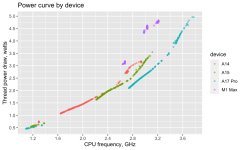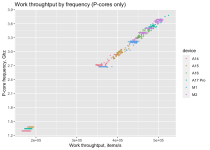We started this discussion in the iPhone 15 thread but I think it makes sense to make it a separate topic. To give a brief recap, I wrote a simple tool that loads up the CPU cores on Apple devices and measures their power draw and CPU frequency. You can find this tool here: https://github.com/mr-mobster/AppleSiliconPowerTest and feedback as well as test results on more devices are very appreciated!
With the new data on running multiple threads and fixing some bugs in how I analysed it, the samples now cover a nice range of frequencies on several devices. Putting it on a plot, we get a fairly neat approximation of power curve of multiple Apple CPUs.

Some basic observations. At 3Ghz, A17 uses about 0.5 watts (or 15%) less power than A14/A15. At 3.5 watts, A17 runs around 7% faster than A15. At 5 watts, A17 gains 0.5Ghz on Firestorm (that's 15% better performance at the same power). At 3.6 Ghz, A17 uses ~ 20% less power than M2. On the other hand, A16 and A17 are very close, which again aligns with the results by Geekerwan (IMO it makes sense as A16 is an efficiency-focused design for high-end smartphones).
It does look to me like A17 aims to improve the relative efficiency at higher frequencies (>3Ghz/3 watts) compared to A15 which looks like it targets improved efficiency at around 2.8-3Ghz/2.5 watts. I think gives addition credibility to the idea that Coll (Apple's new CPU architecture) has been developed with high-performance desktop in mind.
Here is the work throughput for used power (combined P+E core use, take with a grain of salt)

And probably my favourite graph, predicted power/frequency curve for A17! This uses a polynomial of fourth degree to predict power usage from frequency (going higher does not improve the fit).

Next steps:
- A14 graph looks a bit weird, might want to collect more samples from other devices
With the new data on running multiple threads and fixing some bugs in how I analysed it, the samples now cover a nice range of frequencies on several devices. Putting it on a plot, we get a fairly neat approximation of power curve of multiple Apple CPUs.
Some basic observations. At 3Ghz, A17 uses about 0.5 watts (or 15%) less power than A14/A15. At 3.5 watts, A17 runs around 7% faster than A15. At 5 watts, A17 gains 0.5Ghz on Firestorm (that's 15% better performance at the same power). At 3.6 Ghz, A17 uses ~ 20% less power than M2. On the other hand, A16 and A17 are very close, which again aligns with the results by Geekerwan (IMO it makes sense as A16 is an efficiency-focused design for high-end smartphones).
It does look to me like A17 aims to improve the relative efficiency at higher frequencies (>3Ghz/3 watts) compared to A15 which looks like it targets improved efficiency at around 2.8-3Ghz/2.5 watts. I think gives addition credibility to the idea that Coll (Apple's new CPU architecture) has been developed with high-performance desktop in mind.
Here is the work throughput for used power (combined P+E core use, take with a grain of salt)
And probably my favourite graph, predicted power/frequency curve for A17! This uses a polynomial of fourth degree to predict power usage from frequency (going higher does not improve the fit).
Next steps:
- A14 graph looks a bit weird, might want to collect more samples from other devices
Attachments
Last edited:


